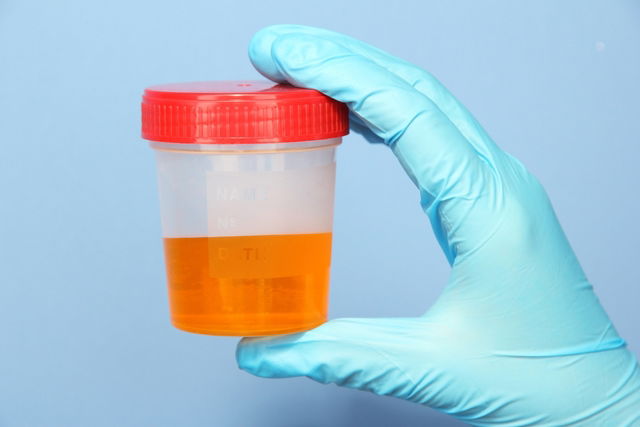Having bilirubin in your urine is normally a sign of a liver problem. This substance can give your urine a dark yellow or orange tinge, and its presence is usually confirmed through a urine test.
Bilirubin is a product of hemoglobin breakdown. Once it is broken down, bilirubin becomes dissolvable in the liver so that it can be easily eliminated through the digestive system. This type of bilirubin is called direct bilirubin. It is is transported to the bile ducts and the intestines, where it is further broken down and eliminated in the stool as stercobilinogen.
When there are problems in the liver or bile ducts, direct bilirubin reenters the circulatory system, and is filtered through the kidneys and eliminated in the urine.

The main causes of bilirubin in the urine are:
1. Hepatitis
Hepatitis is one of the main causes of bilirubin in the urine. Because of the liver inflammation, conjugated bilirubin is unable to exit along the normal elimination tract. It reenters the circulatory system, and is then filtered through the kidneys and eliminated in the urine.
Hepatitis is a liver inflammation that can occur due to a viral infection, recurrent medication use or an autoimmune disease. Other common symptoms of hepatitis include fever, headache, abdominal swelling and light-colored stools. If left untreated, it can also cause jaundice, which is characterized by yellowing of the eyes and skin. Learn more about the symptoms of hepatitis and what can cause this condition.
What to do: If you suspect you have hepatitis, you should see your family doctor for further testing, like bloodwork that looks for the hepatitis virus and evaluates the liver enzymes. The doctor may also order a urine test. Once confirmed, the doctor can initiate treatment, which will depend on the type of hepatitis identified. The doctor will likely advise rest and increased fluid intake, as well as medications, like Interferon.
See the symptoms associated specifically with hepatitis A and when you should see a doctor.
2. Cirrhosis
Cirrhosis is characterized by chronic and progressive inflammation of the liver. It leads to decreased functioning of the liver and interferes with the flow of bilirubin into the bile ducts and intestines. Therefore, the bilirubin reenters the circulatory system and is then eliminated through the urine.
Hepatic cirrhosis can occur as a consequence of hepatitis, but it is usually related to alcohol abuse. Other common symptoms of cirrhosis include weakness, excessive fatigue, weight loss with no apparent cause, loss of appetite, muscular atrophy and renal failure. Read more about liver inflammation and the symptoms associated with it.
What to do: Treatment is usually monitored by a family doctor or liver specialist, and will vary depending on the underlying cause. Most times, the doctor will advise discontinuation of any alcohol and recommend a diet with vitamin supplementation to prevent nutritional deficiencies. Some doctors may recommend a loose version of a liver detox diet, which will help to clear out any accumulated toxins and promote optimal liver function.
Cirrhosis should be identified as quickly as possible to avoid further worsening of this condition, as severe damage may require a liver transplant.
3. Liver cancer
Just like hepatitis or cirrhosis, liver cancer is also associated with worsening inflammation of the organ. This can lead to the elimination of direct bilirubin through the urine.
Liver cancer is most frequent in people with fatty liver, and in those who use anabolic steroids frequently. Common symptoms of this type of cancer include abdominal pain, loss of appetite for no apparent reason, excessive fatigue, yellow eyes, and constant nausea.
What to do: If you suspect you have liver cancer, you should see a doctor immediately to order a work-up. Tests that doctor orders may include an abdominal ultrasound or CT scan, as well a blood work to look at your liver enzyme levels. If liver cancer is present, the doctor will likely recommend surgical removal of the affected portions of the liver will chemotherapy following.
Read more about the symptoms of liver disease you should not ignore.
4. Gallstones
Stones in the gallbladder or bile ducts can also cause bilirubin in the urine. This occurs because the stones obstruct the flow of direct bilirubin to the intestines. It is forced to reenter circulation, where it is then filtered through the kidneys and eliminated in the urine.
Gallstones usually occur due to changes to bile production, which can be triggered by your diet, lifestyle habits or prolonged use of birth control. The main sign of gallstones is biliary colic, which is an intense pain felt on the right side of the abdomen. Other common symptoms include loss of appetite, diarrhea and yellow eyes. Learn more about the symptoms and causes of gallstones.
What to do: The most common form of treatment for recurrent gallstones is the surgical removal of the gallbladder. The patient is then advised to follow an appropriate diet that is rich in fruits, vegetables and whole grains and low in fatty or fried foods. Check out the natural remedies for gallstones that you can use a complement to your prescribed treatment.
